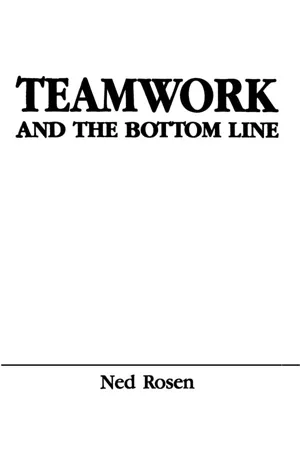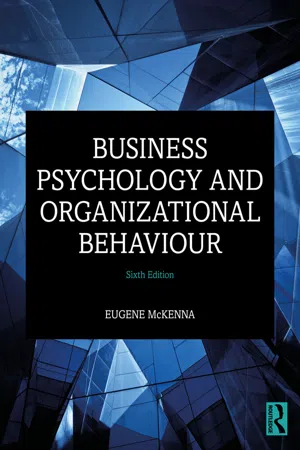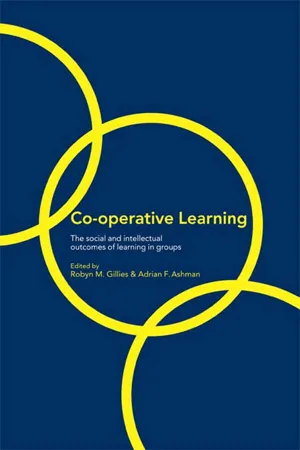Business
Group Cohesiveness
Group cohesiveness refers to the degree of unity and solidarity within a group. It reflects the extent to which members are attracted to and motivated to remain part of the group. High group cohesiveness can lead to increased collaboration, communication, and commitment among team members, ultimately contributing to improved performance and productivity.
Written by Perlego with AI-assistance
Related key terms
Related key terms
1 of 4
Related key terms
1 of 3
9 Key excerpts on "Group Cohesiveness"
- eBook - ePub
Essentials of Social Psychology
An Indian Perspective
- Shubhra Mangal, Shashi Mangal(Authors)
- 2022(Publication Date)
- Routledge(Publisher)
- The power of this tendency of making the members stick together is known as cohesiveness present in the group. Accordingly, the term cohesiveness of the group represents the degree to which the members of a group wish to remain in the group.
- The center point of attraction or purpose of making members stick together is their striving for achieving some common interests or broad purposes of the group.
- The mutual liking of the members for each other and their loyalty and commitment for the group adds much towards keeping cohesiveness of the group at a quite higher level.
- Cohesion represents a process of group formation or team building and is therefore not static but works as a dynamic phenomenon for shaping and reshaping the structural as well as working composition of a functioning group.
In this way, a cohesive group is one in which:- There are quite specific common goals for the common striving of the members for a purpose.
- Members of similar liking and background willingly join and try to retain their membership in the group.
- In spite of facing so many odds and changing conditions, it remains intact.
- The members are concerned with their membership and have a bond of togetherness and loyalty towards the group with a strong motivation for contributing to the group’s welfare, to take part in its activities and to further its objectives to the degree possible on their part.
Usefulness of the Group Cohesiveness: Group Cohesiveness is useful and essential for the proper functioning of the groups working towards attaining some specific purposes or goals for the reasons such as:- Increasing the motivation of the members and raising their morale (Mullen and Cooper, 1994).
- Contributing towards the potency and vitality of the group
- Steven G. Rogelberg(Author)
- 2006(Publication Date)
- SAGE Publications, Inc(Publisher)
The concept of Group Cohesiveness has a wide appeal in research in applied psychology in such diverse areas as organizational behavior, social psychology, military psychology, sport psychology, educational psychology, and counseling. Much of this interest is inspired by the widely shared recognition that keeping groups together is important to the successful functioning of systems relying on group work. Aside from a concern with what leads group members to remain with a group, the interest in Group Cohesiveness is also inspired by the assumption that more cohesive groups function better, at least in part because members of more cohesive groups presumably are more willing to exert themselves on behalf of the group. Evidence for this proposition is mixed, however. To address this issue, Brian Mullen and Carolyn Copper (1994) integrated the results of many studies on the relationship between Group Cohesiveness and group performance. Their conclusion is that Group Cohesiveness may better be viewed as a construct with different aspect, and that the aspect of cohesiveness that has to do with group members’ commitment to task performance and goal achievement is the most important in predicting group performance. Complementing these findings, more recent evidence suggests that whether Group Cohesiveness is conducive to group performance is contingent on the extent to which the group embraces high performance goals and norms. If not, high cohesiveness may in fact be associated with lower performance.THE DIMENSIONALITY OF Group CohesivenessGroup Cohesiveness has always been at least implicitly associated with a greater willingness of group members to exert themselves on behalf of the group and therefore with increased group productivity and performance. Some issues complicate our understanding of the concept of Group Cohesiveness and its consequences, however.A first issue is the measurement of Group Cohesiveness. The concept of Group Cohesiveness refers to the forces that bind individuals to the group or the attraction of group members to the group. The most common way to measure Group Cohesiveness, however, is to measure individual group members’ attraction to other group members (i.e., rather than to the group). Interpersonal attraction may be an aspect of Group Cohesiveness, but it is not the only aspect of Group Cohesiveness and might not be the most important one. Indeed, the definition of Group Cohesiveness suggests that attraction to the group as a whole (i.e., rather than to individual members) is more central to the concept. Many studies of Group Cohesiveness may thus fail to capture important aspects of the concept.A second issue follows from the first. Many researchers and practitioners alike tend to think of Group Cohesiveness as a one-dimensional construct, that is, a concept reflected in a single characteristic of the group. Theoretical considerations as well as a review of measurement practices suggest, however, that it may make more sense to think of Group Cohesiveness as a multidimensional construct—in other words, as a concept reflecting different aspects of the group. Interpersonal attraction between group members may be one of these aspects but not the only one. A second important aspect of Group Cohesiveness is cohesiveness as it flows from attraction to the group’s goals and mission and commitment to the group’s task. That is, group members may be attracted to the group because they value what the group is trying to achieve. A third aspect that may be important in the group’s attraction on its members is the value to group members of being a member in the group, per se. Part of a group’s attractiveness may flow from the group’s prestige or from other factors that may render members proud of their membership in the group. As Mullen and Copper’s (1994) review of the literature shows, these three aspects are represented in different studies of Group Cohesiveness, and the relationship between these different aspects is small enough to see them as separate aspects of Group Cohesiveness. Moreover, these different aspects are differently related to group performance.- eBook - ePub
Teamwork and the Bottom Line
Groups Make A Difference
- Ned Rosen(Author)
- 2019(Publication Date)
- Routledge(Publisher)
CHAPTER 4HOW GROUPS AFFECT THEIR MEMBERS
Groups can be strong, binding agents that help to hold a labor force together. They also can be reservoirs of potential energy which, if properly harnessed, can be of great benefit to any organization. But if they are improperly treated or left entirely to their own devices, they can develop organizationally damaging behavior patterns and attitudes.People think and act differently as group members than as individuals. Because groups influence the behavior, attitudes, and motives of their members, it’s important for managers to understand how and why that happens.COHESION AS THE HUMAN GLUE
Cohesion can be defined as: “The degree to which group members feel attracted to their group and desire to remain members of it.” Cohesive groups that are attractive to their members (and usually to nonmembers too) have many important related characteristics. For example, most highly cohesive groups also seem to carry out their activities and interpersonal relations with “vim, vigor and enthusiasm.”1 These features often are referred to as indicators of high “morale.” Morale, in other words, is a group phenomenon.2Just as societal groups have cultural traditions, task groups also have patterns of collective feelings and beliefs that are passed along to new members. Task groups become points of reference, strongly influencing the way their members view themselves in relation to the organization or society at large. The members use the group’s standards or comparison points when making judgments and evaluations.3CONFORMITY PRESSURES - GOOD OR BAD?
Such group pressures for uniformity serve valuable functions. They help the group to accomplish its goals and to maintain itself, and help the members develop a source of reinforcement of their opinions -- to create for them a social reality. By helping members to define their relations to their social surroundings, the group makes it easier to coordinate members’ actions. - eBook - ePub
Teamwork and the Bottom Line
Groups Make A Difference
- Ned Rosen(Author)
- 2014(Publication Date)
- Psychology Press(Publisher)
CHAPTER 4HOW GROUPS AFFECT THEIR MEMBERSGroups can be strong, binding agents that help to hold a labor force together. They also can be reservoirs of potential energy which, if properly harnessed, can be of great benefit to any organization. But if they are improperly treated or left entirely to their own devices, they can develop organizationally damaging behavior patterns and attitudes.People think and act differently as group members than as individuals. Because groups influence the behavior, attitudes, and motives of their members, it's important for managers to understand how and why that happens.COHESION AS THE HUMAN GLUECohesion can be defined as: “The degree to which group members feel attracted to their group and desire to remain members of it.” Cohesive groups that are attractive to their members (and usually to nonmembers too) have many important related characteristics. For example, most highly cohesive groups also seem to carry out their activities and interpersonal relations with “vim, vigor and enthusiasm.”1 These features often are referred to as indicators of high “morale.” Morale, in other words, is a group phenomenon.2Just as societal groups have cultural traditions, task groups also have patterns of collective feelings and beliefs that are passed along to new members. Task groups become points of reference, strongly influencing the way their members view themselves in relation to the organization or society at large. The members use the group's standards or comparison points when making judgments and evaluations.3CONFORMITY PRESSURES – GOOD OR BAD?Such group pressures for uniformity serve valuable functions. They help the group to accomplish its goals and to maintain itself, and help the members develop a source of reinforcement of their opinions – to create for them a social reality. By helping members to define their relations to their social surroundings, the group makes it easier to coordinate members' actions. - eBook - ePub
- Eugene McKenna(Author)
- 2020(Publication Date)
- Routledge(Publisher)
Similarity of attitudes and goals. The more similar the characteristics (e.g. background, education, and attitudes), the more cohesive the group is likely to be. The assumption here is that people with similar attitudes and objectives will develop closer ties and find each other’s company a source of satisfaction (Forsyth, 2006).- (2) Time spent together. As people spend more time together they are given the opportunity to explore common interests and avail themselves of greater interpersonal attraction (Insko & Wilson, 1977). Physical proximity is a factor that could determine the frequency of contact. A closer relationship is likely to exist between group members who are located near to each other rather than far apart.
- (3) Isolation. Groups that are isolated from other groups may perceive themselves as special. They need to close ranks and be in a state of readiness to counteract threats that may also be prevalent.
- (4) Threats. One would expect the cohesiveness of the group to solidify in the face of external competition or threats. In such conditions, the importance of interdependency is underlined. For example, a cooperative mode of thinking and functioning could be cultivated within a work group faced with unreasonable demands by management for changes in working practices. However, cohesiveness could be dented where the group feels it is unable to withstand the external threat or attack. Here the members feel that the group is now less important as a source of security.
- (5) Size. With an increase in size come fewer opportunities for interaction, coupled with the growth of bureaucratic rules and procedures that could dilute the informal nature of relations and communication among group members. By contrast, smaller groups tend to create conditions for the advancement of cohesiveness because of the greater opportunities for interaction among members (Forsyth, 2006).
- (6) Stringent entry requirements
- eBook - ePub
Cooperative Learning
The Social and Intellectual Outcomes of Learning in Groups
- Adrian Ashman, Robyn Gillies(Authors)
- 2003(Publication Date)
- Routledge(Publisher)
esprit de corps and sense of belonging than do competitive or individualistic experiences (Johnson and Johnson 2003; Johnson and Johnson 1989). Alternatively, social isolation can become a noxious state that creates considerable unhappiness. William James noted that social isolation was the cruelest of tortures, stating, ‘To one long pent up on a desert island, the sight of a human footprint or a human form in the distance would be the most tumultuously exciting of experiences’ (1890: 430). Thus working co-operatively with others is a very powerful procedure for creating positive relationships and building friendships and reducing social isolation.Second, social goals can increase motivation to achieve. Although they are valued in their own right, the pursuit of social goals can help organize, direct and empower individuals to achieve more fully (Farmer et al. 1991; Schneider et al. 1996).Third, being part of a group generates a motive to maintain membership. Group cohesion may be defined as the mutual attraction among members of a group and the resulting desire to remain in the group. Highly cohesive groups, where members like each other, are characterized by greater ease in setting goals, greater likelihood in achieving those goals, and greater susceptibility to influence by group mates (Johnson and Johnson 2003). As cohesiveness increases, absenteeism and turnover of membership decrease, member commitment to group goals increases, feelings of personal responsibility to the group increase, willingness to take on difficult tasks increases, motivation and persistence in working towards goal achievement increase, satisfaction and morale increase, willingness to endure pain and frustration on behalf of the group increases, willingness to defend the group against external criticism or attack increases, willingness to listen to and be influenced by colleagues increases, commitment to each other's professional growth and success increases, and productivity increases (Johnson and Johnson 1989). Fourth, being part of a cooperative effort provides allies and comrades who may help protect a person from being bullied or scapegoated, and who may provide support and assistance during times of adversity and stress (Johnson and Johnson 1989).Finally, social and academic goals seem to be intimately linked. Cooperative behaviour (such as being willing to share and promote others’ success) is associated positively with academic success. Wentzel (1996), for example, in a study of seventh grade English classes, found that the amount of time students spent on their homework depended on the degree to which they endorsed socially responsible goals, such as helping peers understand their assignments. Increases in effort levels from the sixth to the eighth grade depended on the combined pursuit of social and academic goals (as opposed to pursuing academic goals only). - eBook - ePub
A Critical Introduction to Sport Psychology
A Critical Introduction
- Aidan Moran, John Toner(Authors)
- 2017(Publication Date)
- Routledge(Publisher)
Despite the apparent clarity of the preceding theoretical analysis, the construct of cohesion has been criticized on both conceptual and methodological grounds (see reviews by Casey-Campbell and Martens, 2009; Salas et al., 2015). Thus, following a review of cohesion measures, Salas et al. (2015) concluded that studies in this area constitute a “vast, often ambiguous literature that offers little insight about which approaches are most effective” (pp. 366–367). More specifically, at least five problems afflict research on cohesion in sport. First, whereas a minority of investigators define cohesion unidimensionally, the majority study it as a multidimensional construct (Salas et al., 2015). Next, Casey-Campbell and Martens (2009, p. 235) pointed out that the widespread assumption that group cohesion is a dynamic construct “has still to be tested”. One way of doing this is to assess cohesion longitudinally – which has rarely occurred to date (Salas et al., 2015). Third, Mudrack (1989a, p. 38) noted a dilemma at the heart of this construct – the fact that although cohesion is alleged to be a property of groups, the group itself “as a distinct entity is beyond the grasp of our understanding and measurement”. The problem here is that the “field of forces” approach to cohesion (discussed briefly above) is difficult to operationalize and the “attractions to the group” approach is conceptually inadequate because “it focuses exclusively on individuals at the expense of the group, and therefore may not entirely capture the concept of Group Cohesiveness” (Mudrack, 1989a, p. 42). Later in the chapter, we shall return to this thorny issue of how to select the most appropriate unit of analysis (group or individual) when studying cohesion in teams. Fourth, another criticism of research on cohesion comes from Mudrack (1989a), who complained that studies in this field have been plagued by “confusion, inconsistency, and almost inexcusable sloppiness”. To illustrate this allegation, he listed a variety of meanings spawned by the term cohesion. These include interpersonal attraction, group resistance to break-up, a desire to remain in the group, feelings of group membership, and the value that people place on group membership. As these referents do not share many common features, the meaning of the term “cohesion” is elusive. A similar problem was noted by Widmeyer et al. (2002, p. 298) who concluded that “there is no conceptual or theoretical model that can be used as the basis for defining and measuring cohesion”. As an illustration of this difficulty, Mudrack (1989b) reported that of twenty-three investigations conducted between 1975 and 1985, no two studies used the same operational indices of cohesiveness. Unfortunately, there has been little progress in achieving a consensus definition of cohesion. Casey-Campbell and Martens (2009, p. 224) lamented the “lack of consistent definitions and operationalizations” in the field. Finally, Shapcott and Carron (2010) highlighted a recurrent conceptual problem in this field in the form of “reification” – the fallacy of treating an abstraction as a concrete entity. They warned that “reification can arise when individual member responses are summed to reflect a group property without first determining whether some degree of consensus is present” (Shapcott and Carron, 2010, p. 96). For example, they cite the case of two members of a doubles team whose responses are at opposite ends of a continuum of cohesiveness scores. Shapcott and Carron (2010) suggest that it is wrong to reify this property of the team by averaging these extreme scores to indicate that the doubles team has a “moderate” level of cohesiveness. Given such conceptual problems in defining cohesion, what is the best way to measure this construct?Measuring team cohesion
The profusion of different definitions of cohesion is matched by a plethora of different ways of measuring this construct (see review by Salas et al., 2015). Indeed, so plentiful are such measures (amounting to at least thirty-five tests; Salas et al., 2015) that Casey-Campbell and Martens (2009, p. 224) remarked wryly that “there are approximately as many methods for assessing cohesion as there are researches investigating the construct itself”. Although the perceived cohesion of a group can be assessed using methods such as sociograms - Available until 29 Sep |Learn more
- Richard J. Crisp, Rhiannon N. Turner(Authors)
- 2020(Publication Date)
- SAGE Publications Ltd(Publisher)
Chapter 5 ) and their members are typically more committed to the group. There is an inverse correlation between group size and cohesiveness; as more and more members join a group it becomes more difficult to maintain cohesion.We can also think about groups in terms of similarity and interconnectedness. We discussed in Chapter 3 how category formation tends to emphasize similarities and de-emphasize differences within categories, and the same is true within physical groups (Jackson et al., 1991). In a physical group this makes sense; groups usually come together because they have a common goal, which is a de facto basis for similarity.Entitativity
One way of defining groups that encompasses all of the qualities outlined above is in terms ofentitativity. Entitativity refers to the extent to which any collection of individuals can be perceived as ‘groupy’. Although definitions vary, it is generally agreed that entitativity encompasses concepts like cohesiveness, interconnectedness, similarity and common goals as well as importance of the group and the tendency for group members to interact physically with one another. The more a collection of individuals exhibits these characteristics, the more they can be described as a group. Lickel et al. (2000) found that it was possible to divide a wide range of groups into four types of increasing entitativity: loose collections of people (e.g. people standing at a bus stop, people who listen to thrash-metal), social categories (e.g. nationality, race), task groups (e.g. colleagues) and, finally, intimacy groups (e.g. friends) – see Figure 6.1 .Figure 6.1 Four types of group of increasing entitativity. From Lickel et al. (2000)Lickel et al.’s taxonomy provides the perfect way to think about the types of group we will discuss in this chapter. We are going to discuss the effects of the presence of others where there is no prior relationship or interconnectedness between the people involved, but we are also going to talk about task groups, such as work groups that have specific goals. We will not be talking here about social categories (we did this in Chapter 3 ) or high intimacy groups (we discuss the inter-individual processes involved in friendships groups and romantic partners in Chapter 13 - eBook - ePub
- Jerry Toomer, Craig Caldwell, Steve Weitzenkorn, Chelsea Clark(Authors)
- 2018(Publication Date)
- Emerald Publishing Limited(Publisher)
CORNERSTONE 2
CREATING COHESION
TOP TEAM PERFORMANCE REQUIRES COHESION
Teams perform at the highest level when they are cohesive. A unified force drives performance more powerfully than a divided one. Catalysts strengthen team unity and help overcome divisiveness. They unite team members for a common cause.Common purpose is the bedrock of cohesiveness.Cohesiveness is the extent to which team members stick together and remain united in the pursuit of a common goal (Molnau, 2017). You see true cohesion when individuals put the team’s goals ahead of personal interests. As Linda Hill and Kent Lineback write in the Harvard Business Review , “A clear and compelling purpose is the glue that binds together a group of individuals. It is the foundation on which the collective ‘we’ of a real team is built.” (2011) Common purpose is the bedrock of cohesiveness.Highly cohesive teams concentrate on problem-solving, reaching objectives, and improving processes. Team members demonstrate a respect for each other and a commitment to supporting team decisions and strategies. They embrace accountability for themselves and emphasize it for all on the team and the team as a whole. The benefits include higher morale, improved communication, a congenial team environment, loyalty, and greater engagement in team decision-making (Daft & Marcic, 2009).WHAT IS THE PURPOSE OF A TEAM AND WHAT MAKES IT COHESIVE?
Teams exist in all walks of life and in every type of work. The one thing all teams have in common is a purpose that defines their reason for existing. Sports teams exist to win games and championships. Business teams exist to accomplish goals for fulfilling the organization’s mission. In government, teams exist to serve the public. In education, teams exist to promote learning. Community service teams exist to improve local conditions. Artistic teams exist to entertain or enlighten. The purpose of teams is to fulfill a mission more effectively than individuals can when working alone.
Index pages curate the most relevant extracts from our library of academic textbooks. They’ve been created using an in-house natural language model (NLM), each adding context and meaning to key research topics.
Explore more topic indexes
Explore more topic indexes
1 of 6
Explore more topic indexes
1 of 4








